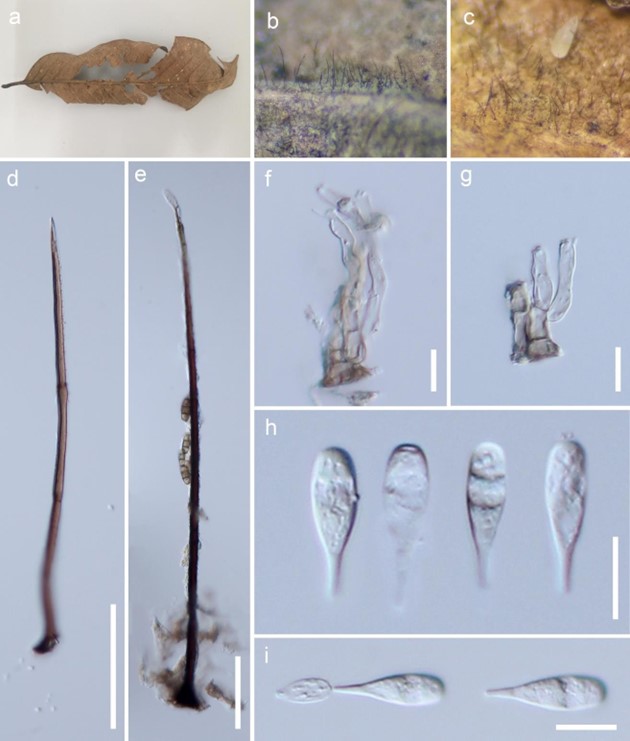Beltraniella ramosiphora C.G. Lin & K.D. Hyde, in Hyde et al., Mycosphere 11(1): 444 (2020)
MycoBank number: MB 555603; Index Fungorum number: IF 555603; Facesoffungi number: FoF 03885;
Etymology – Name reflects the branched conidiophores.
Holotype – MFLU 17-2649.
Saprobic on decaying leaves. Sexual morph: Undetermined. Asexual morph: Colonies on plant substrate effuse, thin, pale brown. Mycelium mostly immersed in the substratum. Setae numerous, erect, arising from radially lobed basal cells, straight or flexuous, unbranched, single, thick-walled, smooth, dark brown, 155–280 μm long, 4.5–7 μm wide at the base, tapering to a pointed apex, arising from a dark brown, swollen, radially lobed cell, 13–23 μm diam. Conidiophores macronematous, long setiform and short non-setiform; long conidiophores single, straight, septate, smooth, thick-walled, unbranched, dark brown at the base and paler at the apex, 260–365 μm long, swollen at the base and 18–22.5 μm wide, 7.5–9 μm wide just above the swollen base, slightly tapering to a pointed apex; short conidiophores, non-setiform, branched, septate, smooth-walled, subhyaline to pale brown, thin-walled, 20–55 μm long, swollen at the base and 4.5– 12 μm wide. Conidiogenous cells polyblastic, integrated, determinate, terminal, cylindrical, oblong, hyaline, smooth, 5–22 µm long, 3–7.5 µm wide at the base. Separating cells ovoid or obovoid, thin-walled, smooth, hyaline, 7.5–11.5 µm long, 3.5–4.6 µm wide in the broadest part. Conidia arise directly from conidiogenous cells or from separating cells, aggregated, acrogenous, simple, dry, straight, smooth, thin-walled, biconic, turbinate to pyriform, rostrate to pointed at proximal end, truncate at the distal end, hyaline with a hyaline supra-equatorial transverse band, 15.5–21 µm long, 4.5–6.5 µm wide in the broadest part.
Culture characteristics – Conidia germinating on PDA within 12 h. Colonies on PDA effuse, pale white from above, light yellow to dark brown from below, reaching a diam. of 4–5 cm in 3 days at 25 °C.
Material examined – Thailand, Chang Wat Lampang, Amphoe Mueang Pan, Tambon Chae Son, on decaying leaf, 24 Sep 2016, CG Lin LCG10-2 (MFLU 17-2649, holotype), ex-type living culture, MFLUCC 17-2582.
GenBank numbers – ITS: MG717500, LSU: MG717502.
Notes – Three Beltraniella species have two types of conidiophores (long setiform and short non-setiform), viz., B. botryospora, B. clara and B. fertilis. Beltraniella ramosiphora differs from B. clara by smooth setae and biconic, turbinate to pyriform conidia, whereas setae are absent and conidia are lageniform in B. clara (Onofri 1983). The long setiform conidiophores of B. ramosiphora are unbranched, while they are branched at the apex in B. fertilis (Heredia et al. 2002). The short non-setiform conidiophores of B. ramosiphora are longer than B. botryospora, and they are branched in B. ramosiphora (Shirouzu et al. 2010).

Figure 45 – Phylogram generated from maximum likelihood analysis based on combined LSU and ITS sequence data of Beltraniaceae. Fifty strains are included in the combined analyses which comprised 1546 characters (884 characters for LSU, 662 characters for ITS) after alignment. Tree topology of the maximum likelihood analysis is similar to the Bayesian and maximum parsimony analyses. The best RaxML tree with a final likelihood value of -7145.370801 is presented. Estimated base frequencies were as follows: A = 0.252192, C = 0.214861, G = 0.266786, T = 0.266162; substitution rates AC = 1.363640, AG = 2.557848, AT = 1.973142, CG = 1.035845, CT = 5.942470, GT = 1.000000; gamma distribution shape parameter α = 0.171878. Bootstrap support values for maximum likelihood and maximum parsimony greater than 50% and Bayesian posterior probabilities greater than 0.8 are indicated above or below the nodes as MLBS/MPBS/PP. The tree is rooted with Anthostomella leucospermi (CBS 110126). Ex-type strains are in bold and black. The newly generated sequences are indicated in blue.

Figure 46 – Beltraniella ramosiphora (MFLU 17-2649, holotype). a Host material. b, c Conidiophores on host surface. d Setae. e Long conidiophore. f, g Short conidiophores with conidiogenous cells. h, i Separating cell and conidia. Scale bars: d, e = 50 μm, f-i = 10 μm.
